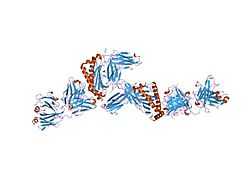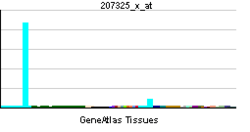MAGEA1
| Melanoma antigen family A, 1 (directs expression of antigen MZ2-E) | |||||||||||||
|---|---|---|---|---|---|---|---|---|---|---|---|---|---|
 Rendering of MAGEA1 from PDB 1W72 | |||||||||||||
| |||||||||||||
| Identifiers | |||||||||||||
| Symbols | MAGEA1 ; CT1.1; MAGE1 | ||||||||||||
| External IDs | OMIM: 300016 HomoloGene: 88717 GeneCards: MAGEA1 Gene | ||||||||||||
| |||||||||||||
| RNA expression pattern | |||||||||||||
 | |||||||||||||
 | |||||||||||||
| More reference expression data | |||||||||||||
| Orthologs | |||||||||||||
| Species | Human | Mouse | |||||||||||
| Entrez | 4100 | n/a | |||||||||||
| Ensembl | ENSG00000198681 | n/a | |||||||||||
| UniProt | P43355 | n/a | |||||||||||
| RefSeq (mRNA) | NM_004988 | n/a | |||||||||||
| RefSeq (protein) | NP_004979 | n/a | |||||||||||
| Location (UCSC) | Chr HG1497_PATCH: 152.35 – 152.35 Mb | n/a | |||||||||||
| PubMed search | n/a | ||||||||||||
Melanoma-associated antigen 1 is a protein that in humans is encoded by the MAGEA1 gene.[1]
This gene is a member of the MAGEA gene family. The members of this family encode proteins with 50 to 80% sequence identity to each other. The promoters and first exons of the MAGEA genes show considerable variability, suggesting that the existence of this gene family enables the same function to be expressed under different transcriptional controls. The MAGEA genes are clustered at chromosomal location Xq28. They have been implicated in some hereditary disorders, such as dyskeratosis congenita.[2]
References
- ↑ van der Bruggen P, Traversari C, Chomez P, Lurquin C, De Plaen E, Van den Eynde B, Knuth A, Boon T (Jan 1992). "A gene encoding an antigen recognized by cytolytic T lymphocytes on a human melanoma". Science 254 (5038): 1643–7. doi:10.1126/science.1840703. PMID 1840703.
- ↑ "Entrez Gene: MAGEA1 melanoma antigen family A, 1 (directs expression of antigen MZ2-E)".
Further reading
- Takahashi K, Shichijo S, Noguchi M et al. (1995). "Identification of MAGE-1 and MAGE-4 proteins in spermatogonia and primary spermatocytes of testis.". Cancer Res. 55 (16): 3478–82. PMID 7627949.
- Celis E, Fikes J, Wentworth P et al. (1995). "Identification of potential CTL epitopes of tumor-associated antigen MAGE-1 for five common HLA-A alleles.". Mol. Immunol. 31 (18): 1423–30. doi:10.1016/0161-5890(94)90158-9. PMID 7823968.
- De Plaen E, Arden K, Traversari C et al. (1994). "Structure, chromosomal localization, and expression of 12 genes of the MAGE family.". Immunogenetics 40 (5): 360–9. doi:10.1007/BF01246677. PMID 7927540.
- Schultz-Thater E, Juretic A, Dellabona P et al. (1994). "MAGE-1 gene product is a cytoplasmic protein.". Int. J. Cancer 59 (3): 435–9. doi:10.1002/ijc.2910590324. PMID 7927954.
- Ding M, Beck RJ, Keller CJ, Fenton RG (1994). "Cloning and analysis of MAGE-1-related genes.". Biochem. Biophys. Res. Commun. 202 (1): 549–55. doi:10.1006/bbrc.1994.1963. PMID 8037761.
- Wang MG, Zakut R, Yi H et al. (1994). "Localization of the MAGE1 gene encoding a human melanoma antigen to chromosome Xq28.". Cytogenet. Cell Genet. 67 (2): 116–9. doi:10.1159/000133810. PMID 8039421.
- Becker JC, Gillitzer R, Bröcker EB (1994). "A member of the melanoma antigen-encoding gene (MAGE) family is expressed in human skin during wound healing.". Int. J. Cancer 58 (3): 346–8. doi:10.1002/ijc.2910580306. PMID 8050815.
- Gaugler B, Van den Eynde B, van der Bruggen P et al. (1994). "Human gene MAGE-3 codes for an antigen recognized on a melanoma by autologous cytolytic T lymphocytes.". J. Exp. Med. 179 (3): 921–30. doi:10.1084/jem.179.3.921. PMC 2191409. PMID 8113684.
- Chen YT, Stockert E, Chen Y et al. (1994). "Identification of the MAGE-1 gene product by monoclonal and polyclonal antibodies.". Proc. Natl. Acad. Sci. U.S.A. 91 (3): 1004–8. doi:10.1073/pnas.91.3.1004. PMC 521442. PMID 8302824.
- Rogner UC, Wilke K, Steck E et al. (1996). "The melanoma antigen gene (MAGE) family is clustered in the chromosomal band Xq28.". Genomics 29 (3): 725–31. doi:10.1006/geno.1995.9945. PMID 8575766.
- Luescher IF, Romero P, Kuznetsov D et al. (1996). "HLA photoaffinity labeling reveals overlapping binding of homologous melanoma-associated gene peptides by HLA-A1, HLA-A29, and HLA-B44.". J. Biol. Chem. 271 (21): 12463–71. doi:10.1074/jbc.271.21.12463. PMID 8647853.
- Tanzarella S, Russo V, Lionello I et al. (1999). "Identification of a promiscuous T-cell epitope encoded by multiple members of the MAGE family.". Cancer Res. 59 (11): 2668–74. PMID 10363990.
- Mallon AM, Platzer M, Bate R et al. (2000). "Comparative genome sequence analysis of the Bpa/Str region in mouse and Man.". Genome Res. 10 (6): 758–75. doi:10.1101/gr.10.6.758. PMC 310879. PMID 10854409.
- Jang SJ, Soria JC, Wang L et al. (2001). "Activation of melanoma antigen tumor antigens occurs early in lung carcinogenesis.". Cancer Res. 61 (21): 7959–63. PMID 11691819.
- Suyama T, Ohashi H, Nagai H et al. (2003). "The MAGE-A1 gene expression is not determined solely by methylation status of the promoter region in hematological malignancies.". Leuk. Res. 26 (12): 1113–8. doi:10.1016/S0145-2126(02)00048-6. PMID 12443884.
- Strausberg RL, Feingold EA, Grouse LH et al. (2003). "Generation and initial analysis of more than 15,000 full-length human and mouse cDNA sequences.". Proc. Natl. Acad. Sci. U.S.A. 99 (26): 16899–903. doi:10.1073/pnas.242603899. PMC 139241. PMID 12477932.
- Nagao T, Higashitsuji H, Nonoguchi K et al. (2003). "MAGE-A4 interacts with the liver oncoprotein gankyrin and suppresses its tumorigenic activity.". J. Biol. Chem. 278 (12): 10668–74. doi:10.1074/jbc.M206104200. PMID 12525503.
- Zerbini A, Pilli M, Soliani P et al. (2004). "Ex vivo characterization of tumor-derived melanoma antigen encoding gene-specific CD8+cells in patients with hepatocellular carcinoma.". J. Hepatol. 40 (1): 102–9. doi:10.1016/S0168-8278(03)00484-7. PMID 14672620.
- Wang LP, Chen HS, Mei MH et al. (2004). "[The genetic polymorphism of melanoma-associated antigen 1 in Chinese normal donors and hepatoma patients]". Zhonghua Gan Zang Bing Za Zhi 12 (3): 151–5. PMID 15059299.